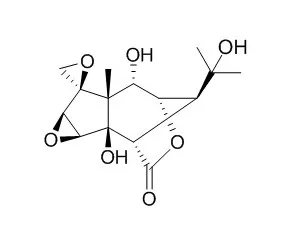| In vitro: |
| Br. J. Pharmacol., 1996, 119(8):1569-76. | | Actions of picrodendrin antagonists on dieldrin-sensitive and -resistant Drosophila GABA receptors.[Pubmed: 8982503] | 1. A series of terpenoid compounds, recently isolated from Picrodendron baccatum, share a picrotoxane skeleton with picrotoxinin, an antagonist of ionotropic GABA receptors.
Referred to as picrodendrins, they inhibit the binding of [35S]-tert-butylbicyclophosphorothionate (TBPS) to rat GABAA receptors.
METHODS AND RESULTS:
Hitherto, their effects on GABA receptors have not been investigated electrophysiologically. Under two-electrode voltage-clamp, the actions of picrodendrins and related terpenoids have been assayed on homooligomeric GABA receptors formed by the expression of a Drosophila GABA receptor subunit (RDLac) in Xenopus oocytes. 2. All the terpenoids tested, dose-dependently antagonized currents induced by 30 microM (EC50) GABA. 3. Tutin and its analogues (dihydrotutin and Isohyenanchin) differ in the structure of their axial C4 substituents. Of these compounds, tutin, which bears an isopropenyl group at this carbon atom, was the most potent antagonist of RDLac homo-oligomers, whereas Isohyenanchin, which bears a hydroxyisopropyl group, was the least potent antagonist tested. 4. Picrodendrins differ mainly in the structure of their C9 substituents. The IC50s of picrodendrins ranged from 17 +/- 1.3 nM (picrodendrin-Q) to 1006 +/- 1.3 nM (picrodendrin-O).
CONCLUSIONS:
As such, the most potent picrodendrins (Q, A and B) were approximately equipotent with picrotoxinin as antagonists of RDLac homo-oligomers. |
|






 Cell. 2018 Jan 11;172(1-2):249-261.e12. doi: 10.1016/j.cell.2017.12.019.IF=36.216(2019)
Cell. 2018 Jan 11;172(1-2):249-261.e12. doi: 10.1016/j.cell.2017.12.019.IF=36.216(2019) Cell Metab. 2020 Mar 3;31(3):534-548.e5. doi: 10.1016/j.cmet.2020.01.002.IF=22.415(2019)
Cell Metab. 2020 Mar 3;31(3):534-548.e5. doi: 10.1016/j.cmet.2020.01.002.IF=22.415(2019) Mol Cell. 2017 Nov 16;68(4):673-685.e6. doi: 10.1016/j.molcel.2017.10.022.IF=14.548(2019)
Mol Cell. 2017 Nov 16;68(4):673-685.e6. doi: 10.1016/j.molcel.2017.10.022.IF=14.548(2019)